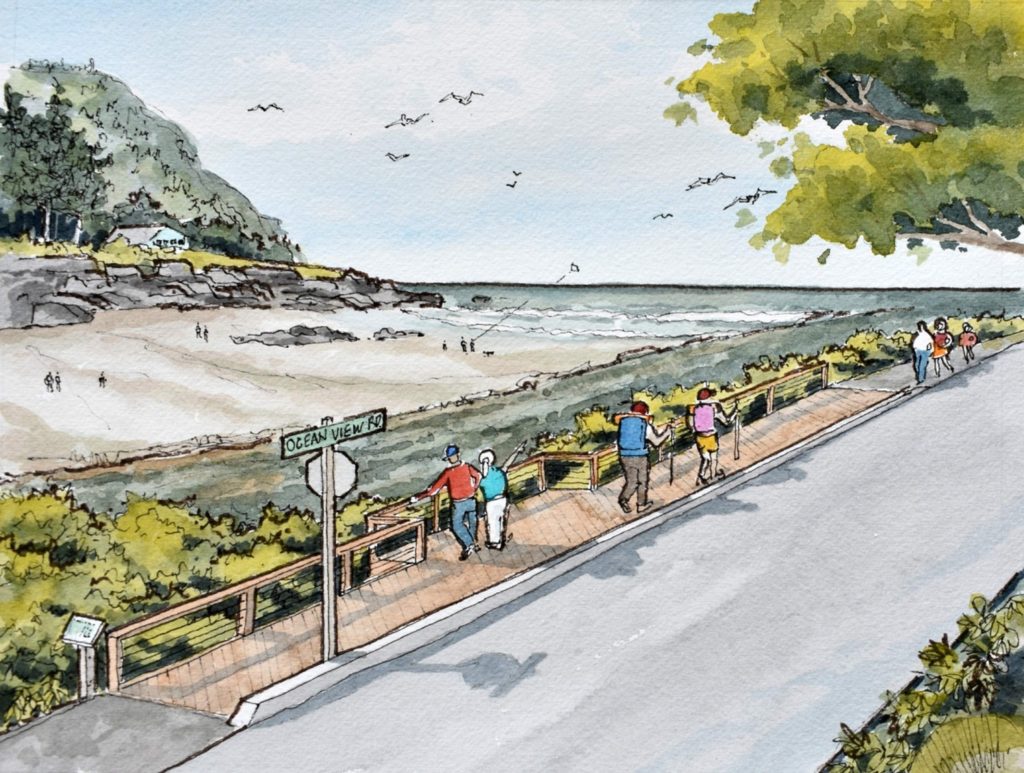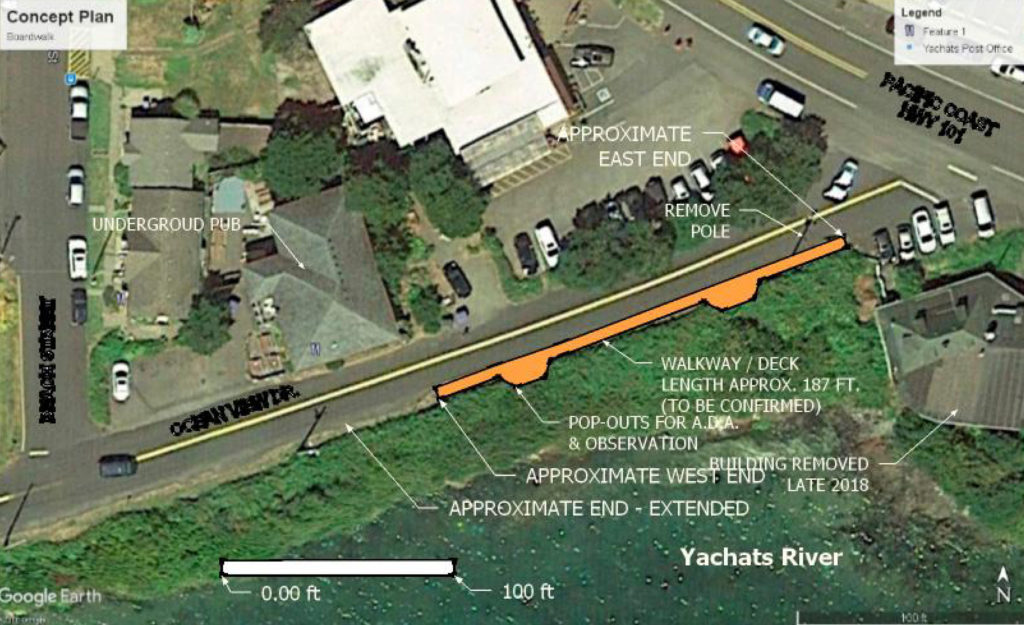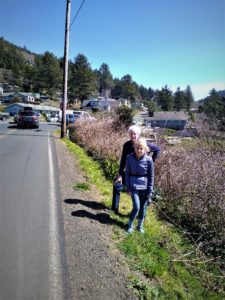
By CHERYL ROMANO/YachatsNews.com
Yachats’ wondrous views can take your breath away — but one of the most scenic might also be among the most hazardous. If a plan that’s gaining momentum in the city pushes ahead, enjoying the natural splendor could get much safer.
The site in question is a narrow strip of land alongside Ocean View Drive near its intersection with U.S. Highway 101 in downtown Yachats.
Because the narrow strip is part of the Oregon Coast Trail and the south section of the 804 Trail, the all-volunteer Yachats Trails Committee has been working with the city to create some type of boardwalk.
The Yachats City Council last month approved a request from the Parks & Commons Commission to allocate $50,000 in the upcoming 2021-22 budget for engineering and other studies.
The objective is to create a boardwalk that would keep trail users separated from vehicles. “With the increase in population and in tourists, this is a dangerous area,” said Joanne Kittel, one of five trails committee leaders.
The narrow, two-lane road can barely accommodate vehicles, which compete for space with pedestrians, many with small children, strollers and dogs.
The area in question — roughly from Beach Street to the stop sign at the Highway 101 intersection — poses a beautiful hazard since it affords a spectacular view of the estuary where the Yachats River meets the Pacific Ocean. There is no shoulder; just a tangle of thorny bushes perched on the edge of a steep drop to the rocks and water below.

Yachats council supportive, so far
“People have actually fallen into the blackberry bushes; vehicles occasionally go too fast on that road, which has a lot of pedestrians going to the Post Office, to restaurants and our state park — it needs to be rectified once and for all,” said Kittel.
Now that the City Council unanimously voted to designate start-up funding — with a possible added $30,000 in the current budget for 804 Trail work – the trails committee can start developing “a firm concept of what we want now.”
That concept could be either a utilitarian walkway, or a more elaborate boardwalk with “bump-outs” for taking in the view, and to accommodate people with mobility issues.
As Bob Langley, another trails leader put it, the options are these: “Either a rather utilitarian structure with the sole purpose of getting people from point A to point B in a safe manner … or an amenity, not just a structure but also a place in which people feel encouraged to congregate, linger, rest and take photographs.”

Ultimately, the choice will be made by the City Council, which so far seems fully supportive of the project. All the details are yet to be determined — scope, design, costs and the myriad other elements involved. But the trails committee has been busy over the past few years developing possibilities.
Trails committee member Loren Dickinson, a retired architect, has done a rendering of what the boardwalk might look like. And in recommendations submitted to the council, different types and designs are laid out: The surface should be non-slip, either of metal, composite, or other material; the width should be 4.5 to 5 feet; there could be interim widened areas to allow faster walkers to pass by, and also to serve as stopping places to take in the view; the length should be about 187 feet; the safety railing could be “open,” with tensioned stainless steel cable to preserve views.
The Council has directed the trails group to keep working with Kevin Shanley of Eugene, a retired landscape architect who has volunteered his services to create possible designs. At present, Kittel and Shanley are discussing how those designs might shake out.
Several Council members have voiced support for making the boardwalk more than a mere walkway.
“It would be a mistake for us to not jump on board and let him (Shanley) design something,” Councilor Ann Stott said in at the council’s March 17 meeting. “A walkway just moves people safely. A boardwalk creates a platform to attract people.”
At the meeting where the Council okayed the go-ahead funding, Kittel said “You’ll always have some who say, ‘Don’t spend the money.’ But we’re a trails town and a walking town.”

“The Council is saying that public safety, to the extent that it involves city infrastructure, is a high priority,” said Councilor Greg Scott.
He noted that pedestrian safety along Highway 101 has been talked about for years, but “that’s ODOT (Oregon Department of Transportation) territory; we don’t have a lot of influence.” But Ocean View Drive, currently a county road, is being turned over to the city this year.
“As we look towards actual ownership of the road, we’re in a better position to determine an appropriate response to safety needs,” Scott told YachatsNews.
Although those involved stress that the project is in a very early stage of planning, Scott had some historical perspective on possible costs.
“In 2011, when I was previously on the Council, we commissioned a study on a scope that was considerably greater than what we’re talking about today,” he said. Estimates then of a much larger project put the cost at about $2 million, he said. For the shorter boardwalk under consideration now, Scott estimated that the price “could easily fall into something like half a million dollars.”
But money from the city’s portion of lodging taxes — some of which must be used for capital projects — could be used to help finance the project. There is also $120,000 or more in the 804 Trail settlement fund that might be allocated, plus potential state and federal trail or tourism grants.
“The momentum is starting to build,” said Kittel. “The mayor and City Council could not be more supportive.” The boardwalk project is “no longer just speculation — we’re working on it now.”
- Cheryl Romano is a Yachats freelance reporter who contributes regularly to YachatsNews.com. She can be reached at Wordsell@gmail.com


